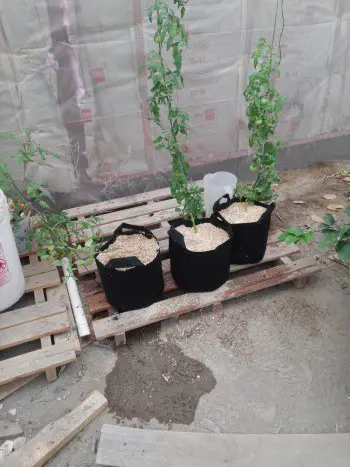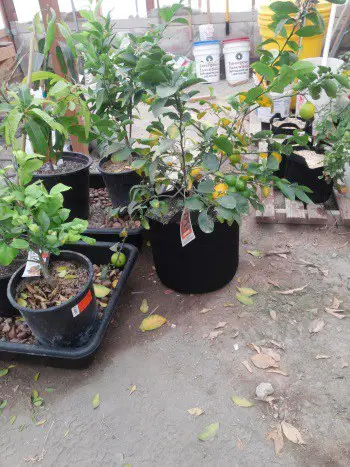We thought we’d experiment with some of those new fabric grow bags potting up a couple of tomatoes and one of our our Meyer Lemon trees we have growing in the greenhouse to see how they go compared to traditional plastic pots.

We’re using 3 gallon gardening bags for the tomatoes (potting up from one gallon pots) and 10 gallon gardening grow bags for the tree (potting up from a 3 gallon container).
The material that the grow bags are made from looks like basic heavy duty landscape fabric. It seems to be stitched really well and durable (the handles held great carrying the tree and should make moving it around much easier).
The sizes looked a little smaller than we expected them to when we opened the packages. After filling them, the volume was definitely right but I would still recommend going up a size larger than you think you need.

For the citrus trees, we use and recommend a well draining, soil-less blend known as Al’s Gritty Mix. It’s easy to kill citrus with kindness by over-watering and the Gritty Mix helps a lot with that issue for us.
Our go-to mix for the rest of the plants we pot up is a modified 5-1-1. We include 1 part fuller’s earth (Turface or oil absorbent) to ours, making it a 5-1-1-1.
We prefer coco coir in lieu of peat moss for our homemade soil-less potting mixes. Peat moss, though a better alternative to animal byproducts and incorrectly processed compost, still has been found to contain damping off and other pathogens that I’d rather not have in my seedling/potting mixes.
The coco coir has proven to work very well for us. We buy it in a compressed brick and soak it in a mortar tub. Scraping/hacking off chunks with a small hand held mattock while the hose is running over it helps to break it apart quickly and ends up only taking a few minutes for it to fully expand.
Potting Mix for Planting Citrus Trees in Fabric Pots
We use and recommend Al’s Gritty Mix for citrus trees and other plants that like to keep their feet dry!
To make this well draining potting mix, you just need to combine equal amounts:
- Fuller’s earth (Turface or oil absorbent – make sure the oil absorbent doesn’t have any other ingredients)
- pine bark fines (I found an inexpensive product called Soil Pep at Home Depot that fits the bill)
- crushed granite / grit (regular poultry grit from the feed store – avoid the shells, though – granite only)
For the mix to drain well, you’ll need to screen it between about 1/8″ and 1/2″. A homemade sieve with scrap lumber and regular window/insect screen is good enough to eliminate the smaller particles.
The only ingredient you need to worry about for the larger pieces is the pine bark fines. Those can be quickly sifted with 1/2″ hardware cloth.
Potting Mix for Planting Tomatoes in Fabric Pots
For potting up tomatoes and almost everything else, we recommend a modified 5-1-1 mix – adding one more part of an additional ingredient.
How to make 5-1-1-1 potting mix:
The recipe for making 5-1-1-1 potting mix is
- 5 parts pine bark fines
- 1 part perlite
- 1 part coir/peat
- 1 part Fuller’s earth
This blend still drains well, but not as much as the Gritty Mix. So I’m not as concerned with the particle sizes and don’t bother screening it other than to pick out some of the larger bits here and there.
Oh, don’t forget to mix in your pre-plant and weekly feed fertilizers!
Update – after using the fabric pots for a couple of years now
The fabric pots seem to be working just as well as regular plastic pots for our use. The fabric is tough and has held up to our abuse like a champ.
The softer fabric and the looks make them suitable as quick inserts into decorative pots in my opinion and the handles make them a little easier to move around when carrying them in and out of the greenhouse for the summer.
All in all they’ve proven durable and we’ve been quite satisfied with them!

